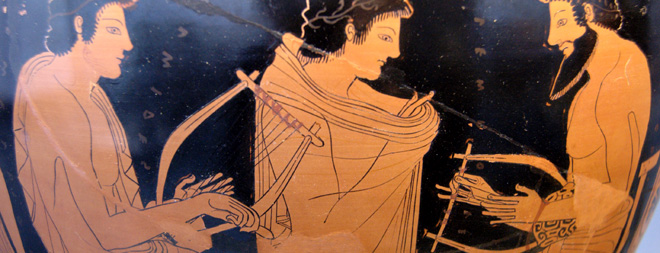Exploring the Evolution of Musical Instruments

(ISNS) -- The invention of musical instruments came about accidentally, suggests an Australian physicist. Developing instruments depended on the materials available, and sometimes the stimulus came from the clamor of battle.
No one knows where music came from, or who Elvis' singing predecessors were, or even when the first instruments were invented, but Neville Fletcher, a retired scientist at the Australian National University in Canberra who has made a hobby of studying the physics of instruments, thinks the key to the invention of instruments is the materials available in each civilization. The people used what they had.
In a paper published in the journal Acoustics Australia, Fletcher wrote that at some time, one of the human noise-makers added words or poetry so that the songs told a story.
"Traditional poetry had rhythms to them," Fletcher said, and someone extended those rhythms to the songs they were singing. No one knows when that happened, but it was music.
Archaeologists debate over when the first instruments were invented. The problem is that most instruments were made of perishable materials -- such as animal skins -- and would have disintegrated long ago. Flutes, one of the basic wind-powered instruments, might be made of bone with holes drilled in them, so they might have been preserved.
Archaeologists have found objects approximately 67,000 years old that might have been simple flutes. Another possible flute, between 40,000 and 60,000 years old, might have been made by Neanderthals. Objects that are clearly flutes were found in China and dated to 7,000-9,000 years ago.
Lyres and harps, made between 2,600-2,500 B.C., were found in the Sumerian city of Ur, the home of biblical Abraham.
Get the world’s most fascinating discoveries delivered straight to your inbox.
Fletcher said that some 10,000 years ago, Australian aborigines developed a didgeridoo -- a wind instrument made when termites hollowed the centers of small eucalyptus plants. Someone noticed that it made a sound if you blew into the tube.
The aborigines also learned to clap sticks together, and other cultures learned you could make a sound by hitting a hollow log with heavy sticks. Soon, people were modifying the target object's length to produce different notes, which eventually led to instruments such as the xylophone.
Then, as civilization advanced into the Bronze Age, metals came, usually in alloy form for strength, especially pewter (tin and lead), brass (copper and zinc) and bronze (copper and tin). That's where war played a role, Fletcher said. The alloys originally were developed for weapons and shields.
Someone noted, for instance, that hitting a bronze helmet with a bronze sword had one definite pitch when it was empty, another if someone's head were in it. That may have led to church bells.
Large bells mostly are made of brass, Fletcher said, because brass is dense and gives a sustained sound. Different shapes give different sounds, and each culture adapted the sounds it like the best.
"Bells are unusual because they have a definite pitch, but you could drive yourself insane tying to tune [other instruments] to a bell," said Scott Metcalfe, director of recording arts and sciences at Baltimore's Peabody Institution. "Bells don't follow normal harmonics." For this reason each bell sounds different.
Other percussion instruments, thin walled instruments like gongs and cymbals, required special bronze alloys because brass can bend and normal bronze can break if hit hard enough. They might have derived from shields and are still made of bronze alloys.
Wood is the secret of stringed instruments such as violins, violas, cellos, double basses as well as pianos and guitars. They might have derived from bows and arrows.
"The twang of the string when plucked by a finger had a definite pitch," Fletcher said.
The strings themselves were once made of animal gut, but metal and polymers have replaced the gut.
Bowing the strings of a violin produces very little sound, according to Metcalfe. The sound you hear is sustained and amplified by the wood and its design.
The wood in a piano also amplifies the sound.
Wood is ideal because it is anisotropic, which means the vibrations are stronger in one direction, along the grain, so the sound can be directed through the structure. The iconic design of the bowed instruments also helps.
The famous violins of Antonio Stradivari and Giuseppe Guarneri from 18th century Italy get their glorious sound from the wood they used which is difficult to duplicate now. Europe was going through a "Little Ice Age" then and the wood was subtly different.
Nonetheless, scientists now can replicate violins that sound at least as good, experts believe.
The first wind instrument might have been a conch shell, Fletcher said. Blowing into a shell produces a definite pitch.
For some instruments, the material is irrelevant to the sound. Shape counts. Conical instruments like brass trumpets and horns and the conch, have a richer sound not because of the brass but because of the shape, according to Metcalfe.
Tubular instruments like the clarinet, pan pipes and flute have simpler sounds, again because of the shape. Also, the metals used in pipe organs are not as important as the cylindrical shape.
Additional Information: On Oct. 25, Neville Fletcher will make a presentation during a meeting of the Acoustical Society of America.
Joel Shurkin is a freelance writer based in Baltimore. He was science editor of the Philadelphia Inquirer and was on a team that won a Pulitzer Prize for coverage of Three Mile Island.
Inside Science News Service is supported by the American Institute of Physics.


